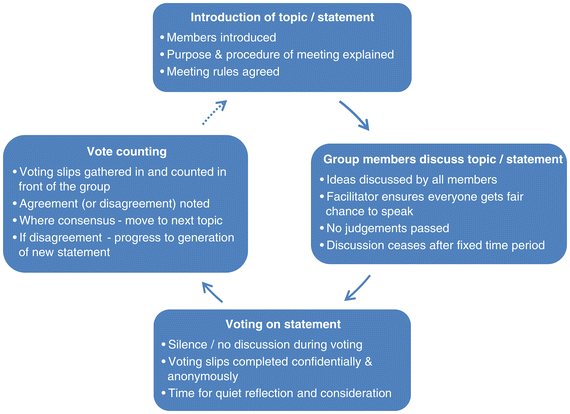User involvement in a Cochrane systematic review: using structured methods to enhance the clinical relevance, usefulness and usability of a systematic review update
- PMID: 25903158
- PMCID: PMC4407304
- DOI: 10.1186/s13643-015-0023-5
User involvement in a Cochrane systematic review: using structured methods to enhance the clinical relevance, usefulness and usability of a systematic review update
Abstract
Background: This paper describes the structured methods used to involve patients, carers and health professionals in an update of a Cochrane systematic review relating to physiotherapy after stroke and explores the perceived impact of involvement.
Methods: We sought funding and ethical approval for our user involvement. We recruited a stakeholder group comprising stroke survivors, carers, physiotherapists and educators and held three pre-planned meetings during the course of updating a Cochrane systematic review. Within these meetings, we used formal group consensus methods, based on nominal group techniques, to reach consensus decisions on key issues relating to the structure and methods of the review.
Results: The stakeholder group comprised 13 people, including stroke survivors, carers and physiotherapists with a range of different experience, and either 12 or 13 participated in each meeting. At meeting 1, there was consensus that methods of categorising interventions that were used in the original Cochrane review were no longer appropriate or clinically relevant (11/13 participants disagreed or strongly disagreed with previous categories) and that international trials (which had not fitted into the original method of categorisation) ought to be included within the review (12/12 participants agreed or strongly agreed these should be included). At meeting 2, the group members reached consensus over 27 clearly defined treatment components, which were to be used to categorise interventions within the review (12/12 agreed or strongly agreed), and at meeting 3, they agreed on the key messages emerging from the completed review. All participants strongly agreed that the views of the group impacted on the review update, that the review benefited from the involvement of the stakeholder group, and that they believed other Cochrane reviews would benefit from the involvement of similar stakeholder groups.
Conclusions: We involved a stakeholder group in the update of a Cochrane systematic review, using clearly described structured methods to reach consensus decisions. The involvement of stakeholders impacted substantially on the review, with the inclusion of international studies, and changes to classification of treatments, comparisons and subgroup comparisons explored within the meta-analysis. We argue that the structured approach which we adopted has implications for other systematic reviews.
Figures
References
-
- Bastian HT. The power of sharing knowledge: consumer participation in the Cochrane Collaboration. 1994. In http://consumers.cochrane.org/sites/consumers.cochrane.org/files/Bastian...; 1994. Accessed 02/07/14.
-
- INVOLVE . Public involvement in systematic reviews: supplement to the briefing notes for researchers. Eastleigh: INVOLVE; 2012.
Publication types
MeSH terms
Grants and funding
LinkOut - more resources
Full Text Sources
Other Literature Sources
Medical




